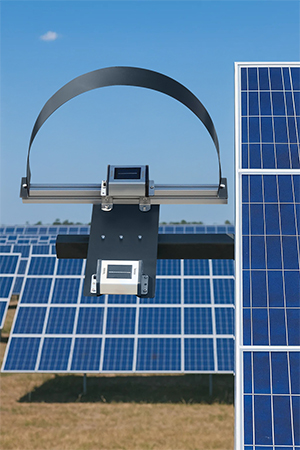In the solar energy field, cloud coverage is one of the most unpredictable variables. The SEVEN Clouding Sensor is engineered to detect the cloud coverage ratio with precision, enabling solar PV operators to adjust operations dynamically, protect assets, and enhance system efficiency.
More than just a weather tool, the SEVEN Clouding Sensor plays a vital role in solar tracker systems, helping them respond intelligently to rapid irradiance changes caused by passing clouds, improving energy harvest and equipment longevity.
What Is a Clouding Sensor?
A Clouding Sensor is a meteorological instrument that identifies cloud coverage ratio by measuring using dual irradiance sensor principle. In solar PV systems, this sensor helps:
- Anticipate short-term dips in power generation.
- Optimize plant operation through dynamic response systems.
- Enhance solar tracker response during variable sky conditions
- Inform cleaning schedules by identifying persistently overcast periods.
The SEVEN Clouding Sensor is built for robust performance, seamless integration, and long-term reliability.
How Does the SEVEN Clouding Sensor Work?
Using a specially designed shade ring, The SEVEN Clouding Sensor operates on a dual-sensor principle as it calculates cloud presence by analyzing the ratio between POA and diffuse irradiances at the POA.
The SEVEN Cloud Sensor consists of two Irradiance Sensors, one Irradiance Sensor is continuously shaded by the shading band to measure Diffuse Irradiance in accordance with IEC 61724 standards, while the other sensor is installed in a way that it is never shaded, thereby measuring the Plane of Array Irradiance (POA). Based on the ratio of these two irradiance values, the cloud coverage percentage (Cloudiness Ratio) over the sky is calculated.
Key Features of SEVEN Clouding Sensor
The Clouding Sensor is newly developed by SEVEN and its main features are as follows:
- Dual Irradiance Measurement: Detects cloud cover through the irradiance ratio method.
- Modbus RTU / RS485 Output: Ideal for SCADA systems and industrial data loggers.
- Status Feedback: Real-time operational status via Modbus registers.
- Compact Design: Easy integration into existing solar monitoring arrays.
Why Use a Clouding Sensor in Solar Plants?
Clouding events can cause unpredictable dips in solar irradiance, especially in high-variability climates. The SEVEN Clouding Sensor helps mitigate this by:
- Triggering curtailment or load-shifting strategies during rapid irradiance changes.
- Protecting trackers and inverters by stabilizing control signals.
- Improving energy yield estimates with real-time cloud data.
- Enhancing data models for predictive maintenance and performance analysis.
Integration & Compatibility of SEVEN Clouding Sensor
The SEVEN Clouding Sensor is fully compatible with well-known inverter brands, SCADA systems, and third-party dataloggers. Its Modbus RTU output enables an easy communication with existing systems. It is also SunSpec Compliant.
Typical Applications of SEVEN Clouding Sensor
The Clouding sensor is widely used in the following fields:
- Utility-scale solar PV plants
- Tracker Systems
- Microgrid systems with adaptive energy management
- Research-grade meteorological stations
- Hybrid systems combining solar and storage
Best Practices for Optimal Results
To maximize performance:
- Install the sensor in an open area with a clear sky dome.
- Avoid shadowing from nearby modules or structures.
- Regularly inspect and clean the sensor dome to maintain accuracy.
- Synchronize sensor data with irradiance sensors for cross-validation.
SEVEN Clouding Sensor: A Clear Advantage
For solar plant operators looking to gain greater insight into the environmental conditions affecting their performance, the SEVEN Clouding Sensor is a must-have tool. With high accuracy, industrial reliability, and intelligent communication, it offers actionable data to keep your system running at peak efficiency, even when the skies change.
Interested in deploying the SEVEN Clouding Sensor?
Contact SEVEN for technical support, system integration advice, or to request a quote.
